Spillover Impacts of the Utilization of Winter Fallow Fields on Grain Production and Carbon Emissions
Abstract
1. Introduction
2. Materials and Methods
2.1. Study Area
2.2. Framework
- (1)
- Identification of winter fallow fields: based on the annual MCF (multiple cropping frequency) maps, the cropland abandonment index (CAI) was applied to extract winter fallow fields.
- (2)
- Impact assessment of using winter fallow fields on grain production: based on data of the grain yield ascertained with the GAEZ model from the FAO, we assessed the changes in grain production due to the utilization of winter fallow fields.
- (3)
- Local and spillover impact assessment of using winter fallow fields on carbon emissions: Firstly, to study the local impact of using winter fallow fields on carbon emissions, since using winter fallow fields in Zhejiang requires the input of more agricultural materials on cropland, such as fertilizer, pesticide, and machinery, the carbon emissions in the grain production stage in Zhejiang will change when considered from the full life cycle perspective. The Greenhouse Gas Emission Factor method was adopted to calculate the carbon emissions at the grain production stage. Additionally, when using winter fallow fields, the spatial distribution of grain production in each municipality will change, which causes the inner grain flows among the municipalities of Zhejiang to also change. Therefore, the changes in carbon emissions from inner grain transport will change. The carbon emissions at the grain transport stage were calculated by the transportation carbon emission model generated by combining the Spatial Interaction Model, Transport Model, and Greenhouse Gas Emission Factor method (the details are given in Section 2.3.4). Secondly, considering that changes in grain production in Zhejiang will also cause changes in the amount of grain necessary to produce in other provinces (which transport grain to or from Zhejiang) as well as the inter-provincial grain flows, the carbon emissions at the grain production stage and from grain transport will change. The results of this process are spillover impacts of using winter fallow fields on carbon emissions. In detail, the spillover impacts of the utilization of winter fallow fields on carbon emissions for regions transporting grain to and from Zhejiang were assessed.
2.3. Methods
2.3.1. Identification of Winter Fallow Fields
2.3.2. Greenhouse Gas Emission Factor Method
2.3.3. Calculation of Grain Consumption
2.3.4. Transportation Carbon Emission Model
- (1)
- First, the Transport Model was applied to calculate the shortest route between each pair of sources of grain supply and demand by different transport modes. Here, we mainly considered three modes: railway, road, and waterway.
- (2)
- Second, the transport cost was calculated based on the transport distance of grain and its transport modes adopted. Considering that the actual data are unavailable, based on the transport cost, the spatial distributions of actual grain production and that of grain consumption, and the spatial flows of grain (the ton-km of grain from the supply origin to the destination), were generated by a doubly constrained Spatial Interaction Model.
- (3)
- Finally, based on the ton-km of grain, the corresponding transport modes, and carbon emission conversion factors, the carbon emissions at the grain transport stage from the grain origin to its destination at the municipal level were determined by the Greenhouse Gas Emission Factor method. In this study, the consumption area undertakes the carbon emissions of grain transport.
2.4. Data
- (1)
- We collected MODIS Surface Reflectance Product (MOD09Q1) data from 2014 to 2018 at a spatial resolution of 250 m (https://ladsweb.modaps.eosdis.nasa.gov/, accessed on 2 January 2023). The MODIS reprojection tool (MRT) was used for the projection, conversion, and assembly of the images (https://lpdaac.usgs.gov/tools/, accessed on 16 January 2023). We selected the MODIS time series dataset because it offers a high temporal resolution (8 days), which is crucial for smoothing the vegetation index. Additionally, it provides continuous observations beginning from the early 21st century [42]. We calculated the EVI2 and developed a yearly EVI2 time series curve for MCF mapping, with the support of a data smoothing method referred to as the harmonic analysis of time series (HANTS), which can reduce noise caused by atmospheric contamination, illumination angles, and cloud interference [42]. EVI2 has the advantages of improved sensitivity in high-biomass regions and minimized atmospheric and soil influence for monitoring the crop growth condition.
- (2)
- We collected National Land Cover Data (NLCD) from the Data Center for Resources and Environmental Sciences, Chinese Academy of Sciences (RESDC) (http://www.resdc.cn, accessed on 6 February 2023) to obtain the cropland mask before processing the remote sensing data. To reduce the influence of cropland change, we extracted the intersection of four periods of the cropland mask (i.e., 2000, 2005, 2010, and 2015) as the research range of croplands. Agricultural production data of wheat were adopted from GAEZ v4 (https://gaez.fao.org/, accessed on 12 February 2023). The Food and Agriculture Organization of the United Nations (FAO) and the International Institute for Applied Systems Analysis (IIASA) have cooperated over several decades to develop and implement the Agro-Ecological Zones (AEZ) modeling framework and databases. The agricultural production spatial data were produced by aggregating national production statistics to individual spatial units (grid cells) used a “downscaling” method, with a 5 arc-minute resolution for 26 major crops/crop groups. We resampled all spatial data to the same spatial resolution of 250 m.
- (3)
- Agricultural materials (e.g., pesticides, fertilizer, irrigation, plastic film, and machinery) on cropland at a municipal scale were collected from the yearbook of each province in China [50,51,52]. The corresponding carbon emission factors of agricultural materials were obtained from the IPCC, the authorities, and published studies (Table 1). The amount of utilization of winter fallow fields equates to the increase in sown area. So, based on the agricultural materials per unit of sown area in 2018 in each municipality and their corresponding carbon emission factor, we calculated the carbon emissions at the production stage per unit of sown area.
- (4)
- The transport network data were extracted from CIESIN and OpenStreetMap. Meanwhile, since the carbon emission conversion factors for different transport modes adopted in China (National Standards IV in 2015) are equivalent to the UK standards (Euro IV in 2015) since 2000, we adopted the UK GHG Conversion Factors to approximate the corresponding factors in China [28] (Table 2).
- (5)
- The grain consumption coefficients of livestock and poultry meat, milk and milk products, eggs, and aquatic products were obtained from public works in the literature (Table 3).
3. Results
3.1. Spatial Distribution of Winter Fallow Fields
3.2. Impacts of the Utilization of Winter Fallow Fields on Grain Production
3.3. Local Impacts of the Utilization of Winter Fallow Fields on Carbon Emissions
3.4. Spillover Impacts of the Utilization of Winter Fallow Fields on Carbon Emissions
- (1)
- Spillover impacts of the utilization of winter fallow fields on carbon emissions for the regions transporting grain to Zhejiang
- (2)
- Spillover impacts of the utilization of winter fallow fields on carbon emissions for the regions transporting grain from Zhejiang
3.5. Trade-Off/Synergy between Grain Production and Carbon Emissions
4. Discussion
5. Conclusions
Supplementary Materials
Author Contributions
Funding
Data Availability Statement
Conflicts of Interest
References
- FAO. Transforming Food and Agriculture to Achieve the SDGs; FAO: Roma, Italy, 2018. [Google Scholar]
- FAO; IFAD; UNICEF; WFP; WHO. The State of Food Security and Nutrition in the World; FAO: Roma, Italy, 2023. [Google Scholar]
- Alexandratos, N. World Food and Agriculture to 2030/50 Proceedings of a Technical Meeting of Experts; FAO: Roma, Italy, 2009; pp. 1–32. [Google Scholar]
- Tilman, D.; Balzer, C.; Hill, J.; Befort, B.L. Global food demand and the sustainable intensification of agriculture. Proc. Natl. Acad. Sci. USA 2011, 108, 20260–20264. [Google Scholar] [CrossRef] [PubMed]
- Erb, K.H.; Lauk, C.; Kastner, T.; Mayer, A.; Theurl, M.C.; Haberl, H. Exploring the biophysical option space for feeding the world without deforestation. Nat. Commun. 2016, 7, 11382. [Google Scholar] [CrossRef] [PubMed]
- Hu, X.; Dong, C.; Zhang, Y. Impacts of cropland utilization patterns on the sustainable use efficiency of cropland based on the human–land perspective. Land 2024, 13, 863. [Google Scholar] [CrossRef]
- Henry, R.C.; Engstrom, K.; Olin, S.; Alexander, P.; Arneth, A.; Rounsevell, M.D.A. Food supply and bioenergy production within the global cropland planetary boundary. PLoS ONE 2018, 13, e0194695. [Google Scholar] [CrossRef]
- Rockstrom, J.; Williams, J.; Daily, G.; Noble, A.; Matthews, N.; Gordon, L.; Wetterstrand, H.; DeClerck, F.; Shah, M.; Steduto, P.; et al. Sustainable intensification of agriculture for human prosperity and global sustainability. Ambio 2017, 46, 4–17. [Google Scholar] [CrossRef] [PubMed]
- Bren, D.A.C.; Reitsma, F.; Baiocchi, G.; Barthel, S.; Güneralp, B.; Erb, K.; Haberl, H.; Creutzig, F.; Seto, K.C. Future urban land expansion and implications for global croplands. Proc. Natl. Acad. Sci. USA 2017, 114, 8939–8944. [Google Scholar] [CrossRef] [PubMed]
- Li, S.; Li, X. Global understanding of farmland abandonment: A review and prospects. J. Geogr. Sci. 2017, 27, 1123–1150. [Google Scholar] [CrossRef]
- Thomson, A.M.; Ellis, E.C.; Grau, H.R.; Kuemmerle, T.; Meyfroidt, P.; Ramankutty, N.; Zeleke, G. Sustainable intensification in land systems: Trade-offs, scales, and contexts. Curr. Opin. Environ. Sustain. 2019, 38, 37–43. [Google Scholar] [CrossRef]
- Zuo, L.; Zhang, Z.; Carlson, K.M.; MacDonald, G.K.; Brauman, K.A.; Liu, Y.; Zhang, W.; Zhang, H.; Wu, W.; Zhao, X.; et al. Progress towards sustainable intensification in China challenged by land-use change. Nat. Sustain. 2018, 1, 304–313. [Google Scholar] [CrossRef]
- Wu, W.; Yu, Q.; You, L.; Chen, K.; Tang, H.; Liu, J. Global cropping intensity gaps: Increasing food production without cropland expansion. Land Use Policy 2018, 76, 515–525. [Google Scholar] [CrossRef]
- Ojha, R.B.; Atreya, K.; Kristiansen, P.; Devkota, D.; Wilson, B. A systematic review and gap analysis of drivers, impacts, and restoration options for abandoned croplands in Nepal. Land Use Policy 2022, 2022, 120106237. [Google Scholar] [CrossRef]
- Daskalova, G.N.; Kamp, J. Abandoning land transforms biodiversity. Science 2023, 380, 581–583. [Google Scholar] [CrossRef] [PubMed]
- Zhang, M.; Li, G.; He, T.; Zhai, G.; Guo, A.; Chen, H.; Wu, C. Reveal the severe spatial and temporal patterns of abandoned cropland in China over the past 30 years. Sci. Total Environ. 2023, 857, 159591. [Google Scholar] [CrossRef] [PubMed]
- Zeng, J.; Luo, T.; Chen, W.; Gu, T. Assessing and mapping cropland abandonment risk in China. Land Degrad. Dev. 2024, 35, 2738–2753. [Google Scholar] [CrossRef]
- Deng, X.; Huang, J.; Rozelle, S.; Zhang, J.; Li, Z. Impact of urbanization on cultivated land changes in China. Land Use Policy 2015, 45, 1–7. [Google Scholar] [CrossRef]
- Qiu, B.; Li, H.; Tang, Z.; Chen, C.; Berry, J. How cropland losses shaped by unbalanced urbanization process? Land Use Policy 2020, 96, 104715. [Google Scholar] [CrossRef]
- Johnson, B.; Xie, Z. Unsupervised image segmentation evaluation and refinement using a multi-scale approach. ISPRS J. Photogramm. Remote Sens. 2011, 66, 473–483. [Google Scholar] [CrossRef]
- Yin, H.; Prishchepov, A.V.; Kuemmerle, T.; Bleyhl, B.; Buchner, J.; Radeloff, V.C. Mapping agricultural land abandonment from spatial and temporal segmentation of Landsat time series. Remote Sens. Environ. 2018, 210, 12–24. [Google Scholar] [CrossRef]
- Zheng, Q.; Ha, T.; Prishchepov, A.; Zeng, Y.; Yin, H.; Koh, L. The neglected role of abandoned cropland in supporting both food security and climate change mitigation. Nat. Commun. 2023, 14, 6083. [Google Scholar] [CrossRef] [PubMed]
- Griscom, B.W.; Adams, J.; Ellis, P.W.; Houghton, R.A.; Lomax, G.; Miteva, D.A.; Shoch, D.; Putz, F.E.; Polasky, S.; Fargione, J.; et al. Natural climate solutions. Proc. Natl. Acad. Sci. USA 2017, 114, 11645–11650. [Google Scholar] [CrossRef] [PubMed]
- Meyfroidt, P.; Schierhorn, F.; Prishchepov, A.V.; Müller, D.; Kuemmerle, T. Drivers, constraints and trade-offs associated with recultivating abandoned cropland in Russia, Ukraine and Kazakhstan. Glob. Environ. Chang. 2016, 37, 1–15. [Google Scholar] [CrossRef]
- Knoke, T.; Bendix, J.; Pohle, P.; Hamer, U.; Hildebrandt, P.; Roos, K.; Gerique, A.; Sandoval, M.L.; Breuer, L.; Tischer, A.; et al. Afforestation or intense pasturing improve the ecological and economic value of abandoned tropical farmlands. Nat. Commun. 2014, 5, 5612. [Google Scholar] [CrossRef] [PubMed]
- Sochacki, S.J.; Harper, R.J.; Smettem, K.R.J. Bio-mitigation of carbon following afforestation of abandoned salinized farmland. GCB Bioenergy 2012, 4, 193–201. [Google Scholar] [CrossRef]
- Yan, M.; Cheng, K.; Luo, T.; Yan, Y.; Pan, G.; Rees, R.M. Carbon footprint of grain crop production in China–based on farm survey data. J. Clean Prod. 2015, 104, 130–138. [Google Scholar] [CrossRef]
- Zuo, C.; Wen, C.; Clarke, G.; Turner, A.; Ke, X.; You, L.; Tang, L. Cropland displacement contributed 60% of the increase in carbon emissions of grain transport in China over 1990–2015. Nat. Food 2023, 4, 223–235. [Google Scholar] [CrossRef] [PubMed]
- Xu, Z.; Chen, X.; Liu, J.; Zhang, Y.; Sophia Chau, S.; Bhattarai, N.; Wang, Y.; Li, Y.; Connor, T.; Li, Y. Impacts of irrigated agriculture on food–energy–water–CO2 nexus across metacoupled systems. Nat. Commun. 2020, 11, 5837. [Google Scholar] [CrossRef] [PubMed]
- Wang, X.; Bodirsky, B.L.; Müller, C.; Chen, K.; Yuan, C. The triple benefits of slimming and greening the Chinese food system. Nat. Food 2022, 3, 686–693. [Google Scholar] [CrossRef] [PubMed]
- Liu, J.; Yang, W.; Li, S. Framing ecosystem services in the telecoupled Anthropocene. Front. Ecol. Environ. 2016, 14, 27–36. [Google Scholar] [CrossRef]
- Liu, J.; Diamond, J. China’s environment in a globalizing world. Nature 2005, 435, 1179–1186. [Google Scholar] [CrossRef] [PubMed]
- Dou, Y.; da Silva, R.F.B.; Yang, H.; Liu, J. Spillover effect offsets the conservation effort in the Amazon. J. Geogr. Sci. 2018, 28, 1715–1732. [Google Scholar] [CrossRef]
- Laurance, W.F.; Sayer, J.; Cassman, K.G. Agricultural expansion and its impacts on tropical nature. Trends Ecol. Evol. 2014, 29, 107–116. [Google Scholar] [CrossRef] [PubMed]
- Kastner, T.; Erb, K.H.; Nonhebel, S. International wood trade and forest change: A global analysis. Glob. Environ. Chang. 2011, 21, 947–956. [Google Scholar] [CrossRef]
- Meyfroidt, P.; Lambin, E.F. Global forest transition: Prospects for an end to deforestation. Annu. Rev. Environ. Resour. 2011, 36, 343–371. [Google Scholar] [CrossRef]
- Zhang, X.; Zhao, C.; Dong, J.; Ge, Q. Spatio-temporal pattern of cropland abandonment in China from 1992 to 2017: A meta-analysis. Acta Geogr. Sin. 2019, 74, 411–420. [Google Scholar]
- Jiang, C.; Song, W. Degree of abandoned cropland and socioeconomic impact factors in China: Multi-level analysis model based on the farmer and district/county levels. Land 2022, 11, 8. [Google Scholar] [CrossRef]
- Wang, Y.; Yang, O.; Yang, Q. The extent, drivers and production loss of farmland abandonment in China: Evidence from a spatiotemporal analysis of farm households survey. J. Clean. Prod. 2023, 414, 137772. [Google Scholar] [CrossRef]
- Liu, L.; Xu, X.; Hu, Y.; Liu, Z.; Qiao, Z. Efficiency analysis of bioenergy potential on winter fallow fields: A case study of rape. Sci. Total Environ. 2018, 628–629, 103–109. [Google Scholar] [CrossRef] [PubMed]
- Li, L.; Pan, Y.; Zheng, R.; Liu, X. Understanding the spatiotemporal patterns of seasonal, annual, and consecutive farmland abandonment in China with time series MODIS images during the period 2005–2019. Land Degrad. Dev. 2022, 33, 1608–1625. [Google Scholar] [CrossRef]
- Shen, G.; Yu, Q.; Zhou, Q.; Wang, C.; Wu, W. From multiple cropping frequency to multiple cropping system: A new perspective for characterizing cropland use intensity. Agric. Syst. 2023, 204, 103535. [Google Scholar] [CrossRef]
- Cheng, K.; Pan, G.; Smith, P.; Luo, T.; Li, L.; Zheng, J.; Zhang, X.; Han, X.; Yan, M. Carbon footprint of China’s crop production—An estimation using agro-statistics data over 1993–2007. Agric. Ecosyst. Environ. 2011, 142, 231–237. [Google Scholar] [CrossRef]
- Chen, Y.; Lu, C. Future grain consumption trends and implications on grain security in China. Sustainability 2019, 11, 5165. [Google Scholar] [CrossRef]
- Tongwane, M.; Moeletsi, M. A review of greenhouse gas emissions from the agriculture sector in Africa. Agric. Syst. 2018, 166, 124–134. [Google Scholar] [CrossRef]
- Eggleston, H.; Buendia, L.; Miwa, K.; Ngara, T.; Tanabe, K. 2006 IPCC Guidelines for National Greenhouse Gas Inventories; Intergovernmental Panel on Climate Change (IPCC): Geneva, Switzerland, 2006. [Google Scholar]
- Min, J.; Hu, H. Estimation of greenhouse gas emissions from agricultural production in China. Chin. Popul. Resour. Environ. 2012, 22, 21–27. (In Chinese) [Google Scholar]
- Ding, R.; Shi, W.; Lv, C.; Lu, H.; Deng, X.; Shao, J.; Cui, J. Prediction of the future food supply and demand balance in Tibet under the background of climate change. Geogr. Sci. 2022, 42, 772–781. (In Chinese) [Google Scholar]
- Yuan, Y.; Song, J.; Yang, C.; Liu, A. Food demand prediction from the perspective of balanced diet pattern. Chin. J. Agric. Resour. Reg. Plan. 2017, 38, 119–123. (In Chinese) [Google Scholar]
- Editorial Board of China Statistical Yearbook. China Statistical Yearbook 2019; China Statistics Press: Beijing, China, 2019. (In Chinese) [Google Scholar]
- Editorial Board of China Rural Statistical Yearbook. China Rural Statistical Yearbook 2019; China Statistics Press: Beijing, China, 2019. (In Chinese) [Google Scholar]
- Rural Socioeconomic Survey Department of the National Bureau of Statistics. China County Statistical Yearbook 2019; China Statistics Press: Beijing, China, 2019. (In Chinese)
- West, T.; Marland, G. A synthesis of carbon sequestration, carbon emissions, and net carbon flux in agriculture: Comparing tillage practices in the United States. Agric. Ecosyst. Environ. 2002, 91, 217–232. [Google Scholar] [CrossRef]
- Liu, X.; Xin, L. Temporal and spatial evolution characteristics of China’s pig grain consumption coefficient. J. Nat. Resour. 2021, 36, 1494–1504. (In Chinese) [Google Scholar]
- Tang, H.; Li, Z. Study on per capita food demand based on the balanced dietary pattern of Chinese residents. Chin. Agric. Sci. 2012, 45, 2315–2327. (In Chinese) [Google Scholar]
- Long, Y.; Sun, J.; Wellens, J.; Colinet, G.; Wu, W.; Meersmans, J. Mapping the Spatiotemporal Dynamics of Cropland Abandonment and Recultivation across the Yangtze River Basin. Remote Sens. 2024, 16, 1052. [Google Scholar] [CrossRef]
- Jiang, Y.; He, X.; Yin, X.; Chen, F. The pattern of abandoned cropland and its productivity potential in China: A four-years continuous study. Sci. Total Environ. 2023, 870, 161928. [Google Scholar] [CrossRef] [PubMed]
- Lei, L.; Li, Y.; Zhou, Z.; Li, N.; Zhao, C.; Li, Q. Cropland abandonment alleviates soil carbon emissions in the North China Plain. Environ. Monit. Assess. 2023, 195, 679. [Google Scholar] [CrossRef] [PubMed]
- Næss, J.; Cavalett, O.; Cherubini, F. The land–energy–water nexus of global bioenergy potentials from abandoned cropland. Nat. Sustain. 2021, 4, 525–536. [Google Scholar] [CrossRef]
- Chang, X.; Chai, Q.; Wu, G.; Zhu, Y.; Li, Z.; Yang, Y.; Wang, G. Soil organic carbon accumulation in abandoned croplands on the Loess Plateau. Land Degrad. Dev. 2017, 28, 1519–1527. [Google Scholar] [CrossRef]
- Rey Benayas, J.; Martins, A.; Nicolau, J.; Schulz, J. Abandonment of Agricultural Land: An Overview of Drivers and Consequences. CABI Reviews. 2007. 14p. Available online: https://www.cabidigitallibrary.org/doi/10.1079/PAVSNNR20072057 (accessed on 16 January 2024).
- Qiu, B.; Yang, X.; Tang, Z.; Chen, C.; Li, H.; Berry, J. Urban expansion or poor productivity: Explaining regional differences in cropland abandonment in China during the early 21st century. Land Degrad. Dev. 2020, 31, 2540–2551. [Google Scholar] [CrossRef]
- Zhang, Y.; Zhang, X.; Zhou, W.; Li, J.; Weng, Z.; Gao, X. The impact of and mechanism behind high standard farmland construction in farmland abandonment: A moderated mediating analysis. Land 2024, 13, 846. [Google Scholar] [CrossRef]
- Wei, Y.; Wen, J.; Zhou, Q.; Zhang, Y.; Dong, G. Mapping cropland abandonment in the cloudy hilly regions surrounding the southwest basin of China. Land 2024, 13, 586. [Google Scholar] [CrossRef]
- Guo, A.; Yue, W.; Yang, J.; Xue, B.; Xiao, W.; Li, M.; He, T.; Zhang, M.; Jin, X.; Zhou, Q. Cropland abandonment in China: Patterns, drivers, and implications for food security. J. Clean. Prod. 2023, 418, 138154. [Google Scholar] [CrossRef]
- Han, Z.; Song, W. Abandoned cropland: Patterns and determinants within the Guangxi karst mountainous area, China. Appl. Geogr. 2020, 122, 102245. [Google Scholar] [CrossRef]
- He, Y.; Xie, H.; Peng, C. Analyzing the behavioural mechanism of farmland abandonment in the hilly mountainous areas in China from the perspective of farming household diversity. Land Use Policy 2020, 99, 104826. [Google Scholar] [CrossRef]
- Walling, E.; Vaneeckhaute, C. Greenhouse gas emissions from inorganic and organic fertilizer production and use: A review of emission factors and their variability. J. Environ. Manag. 2020, 276, 111211. [Google Scholar] [CrossRef] [PubMed]
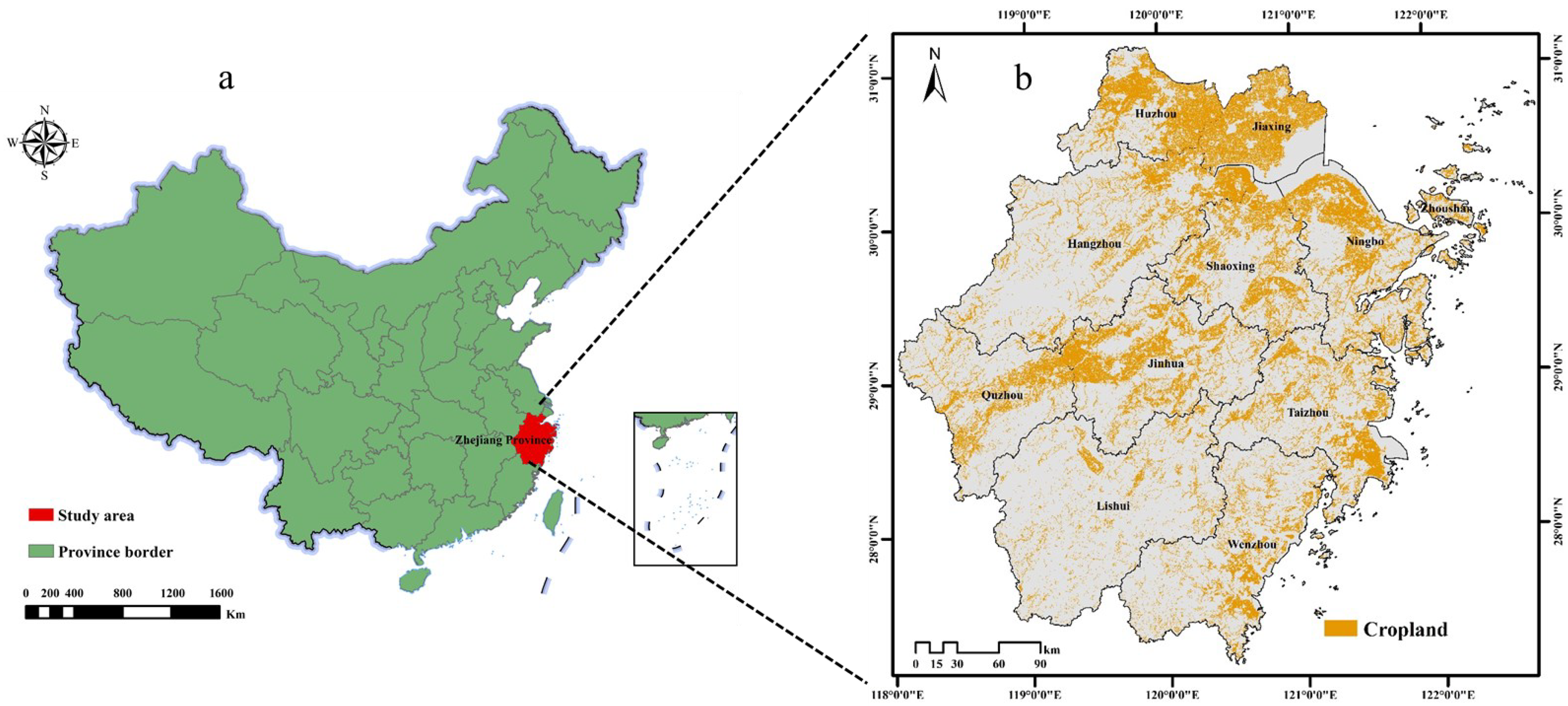

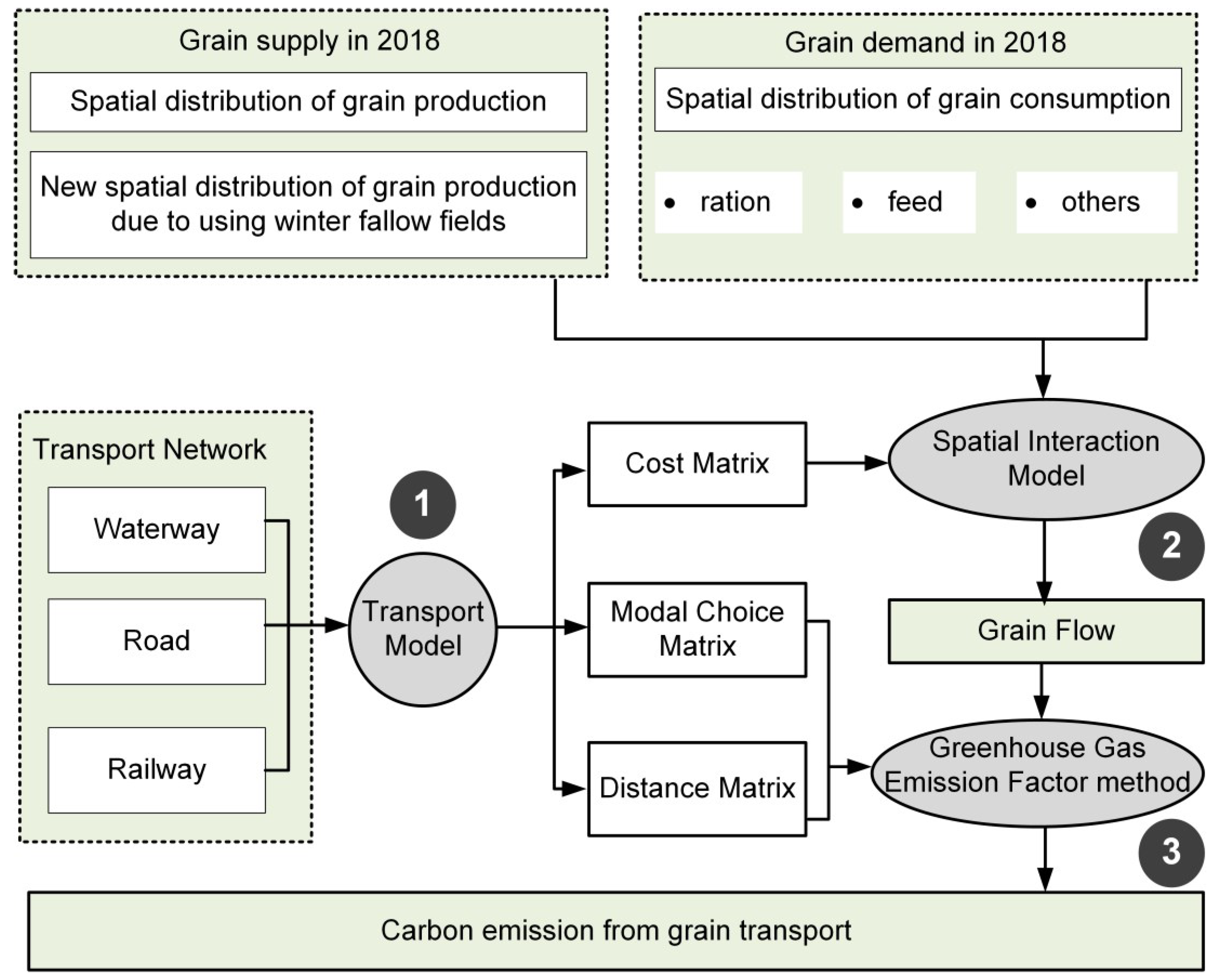
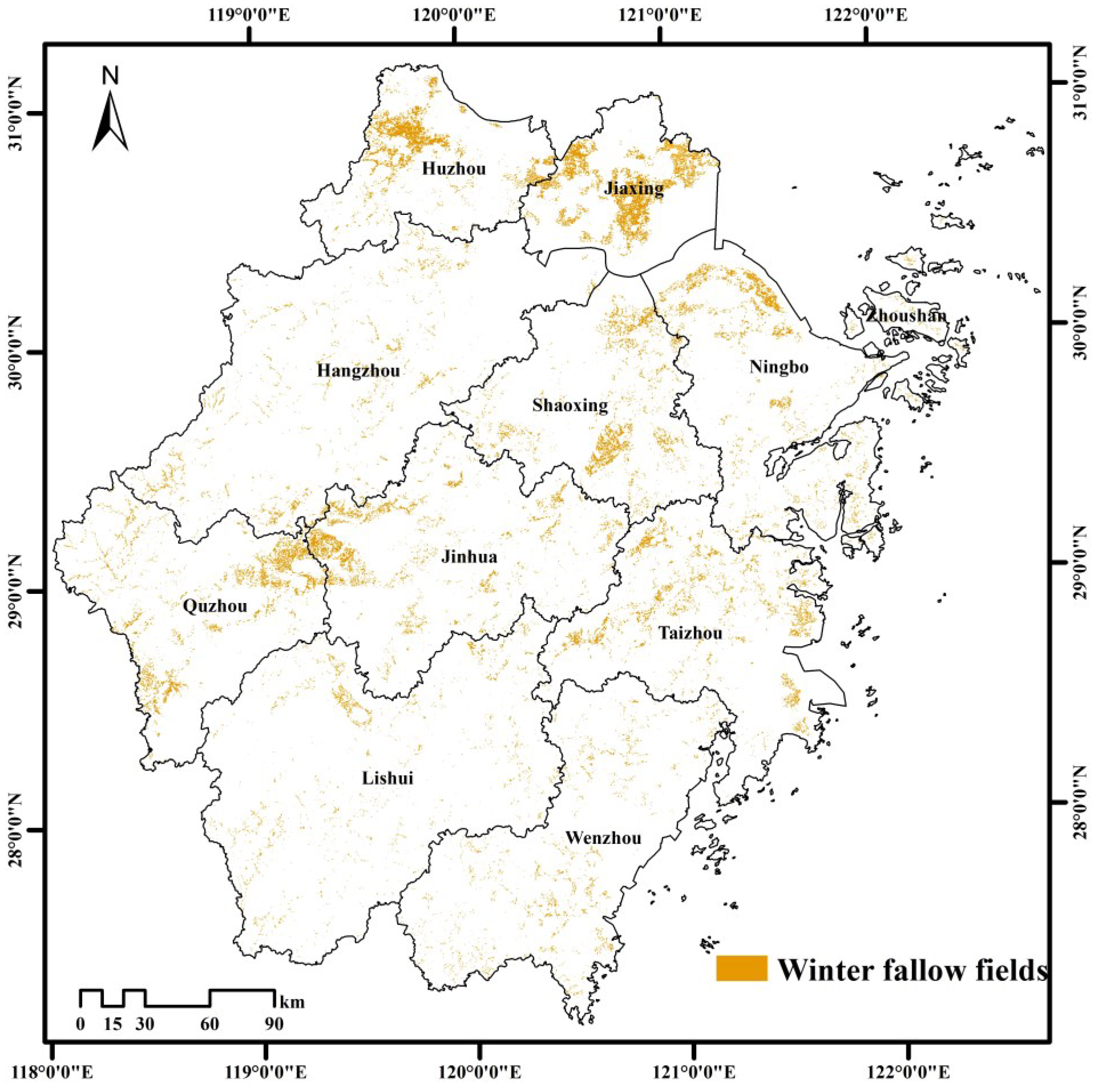
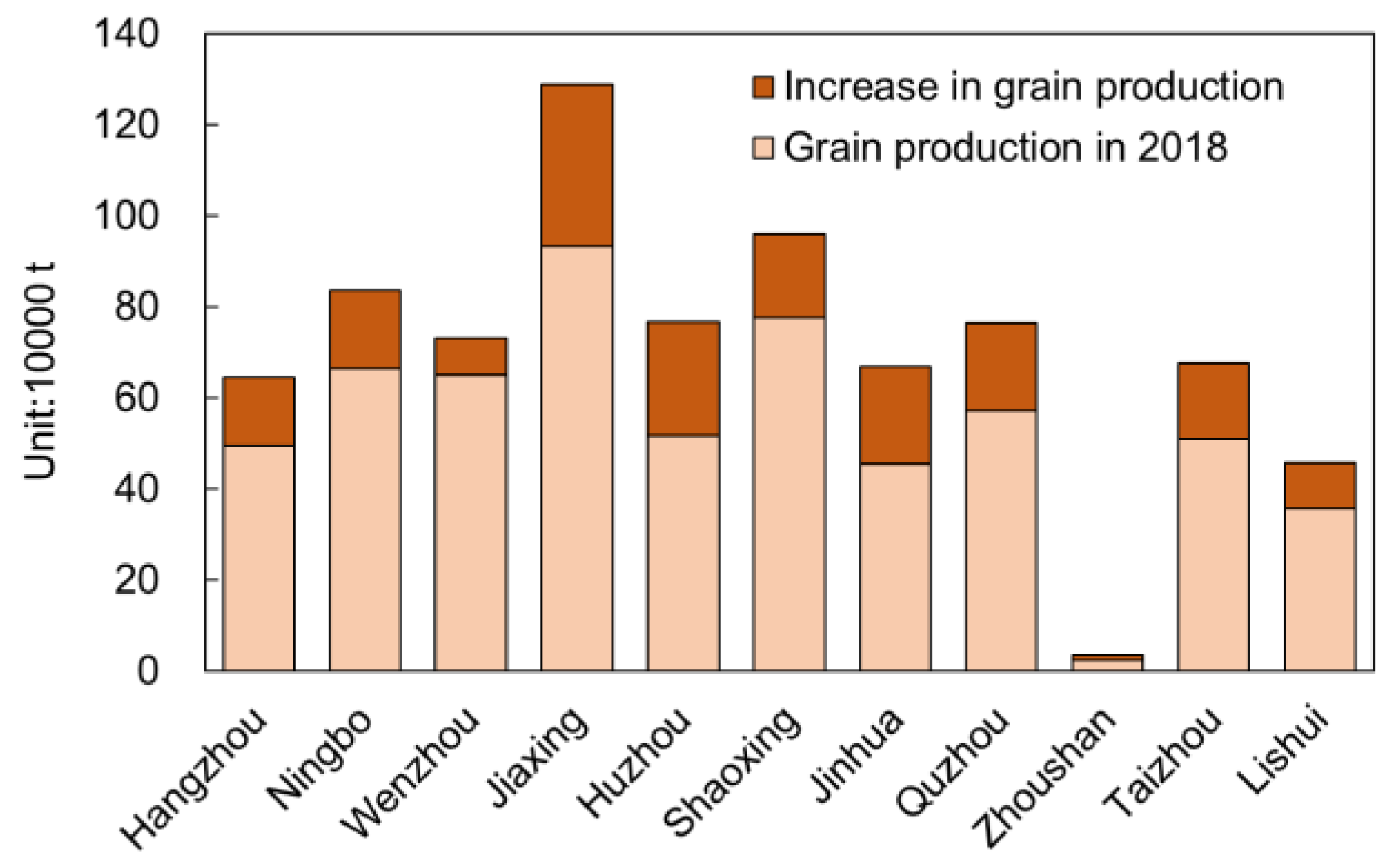

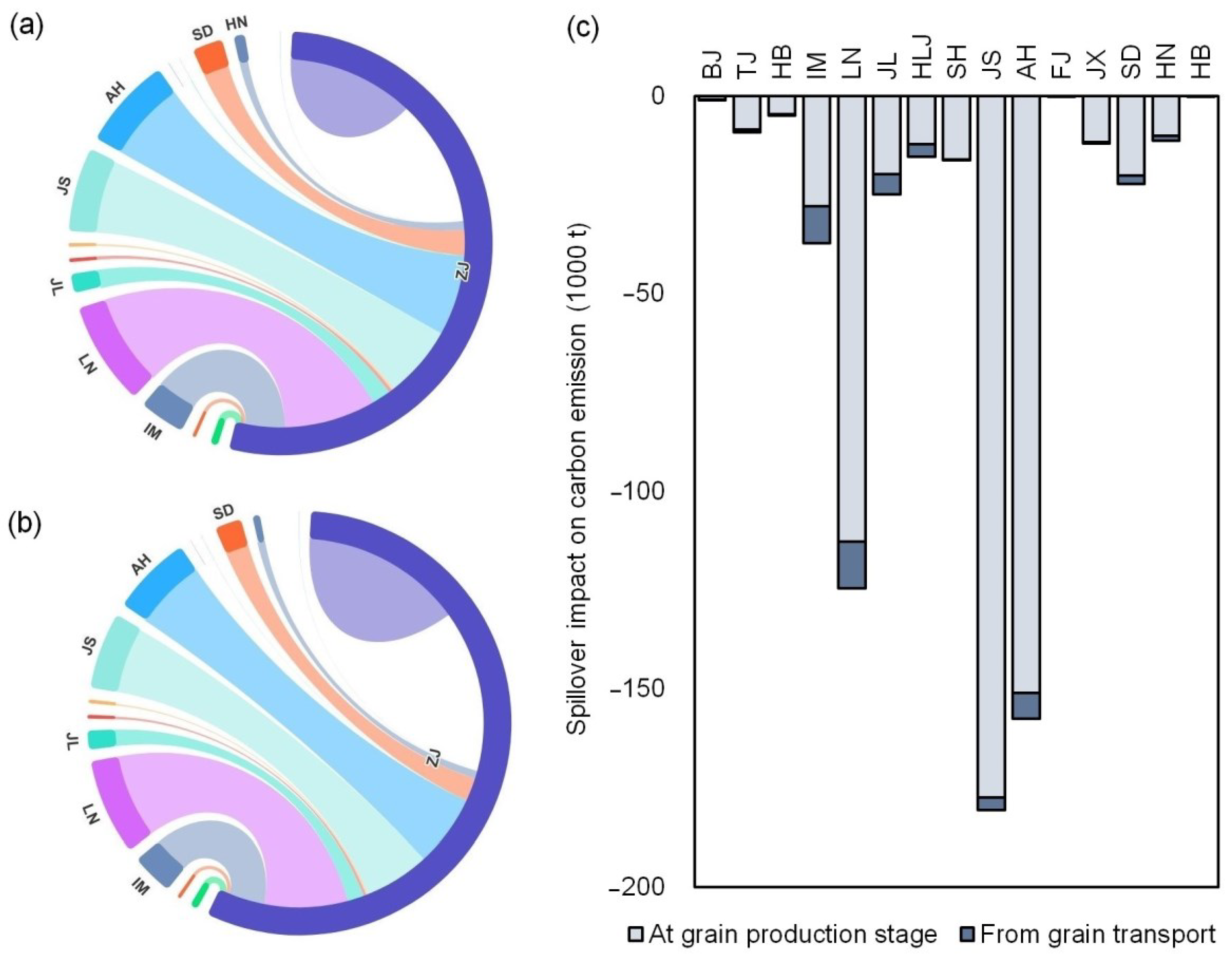
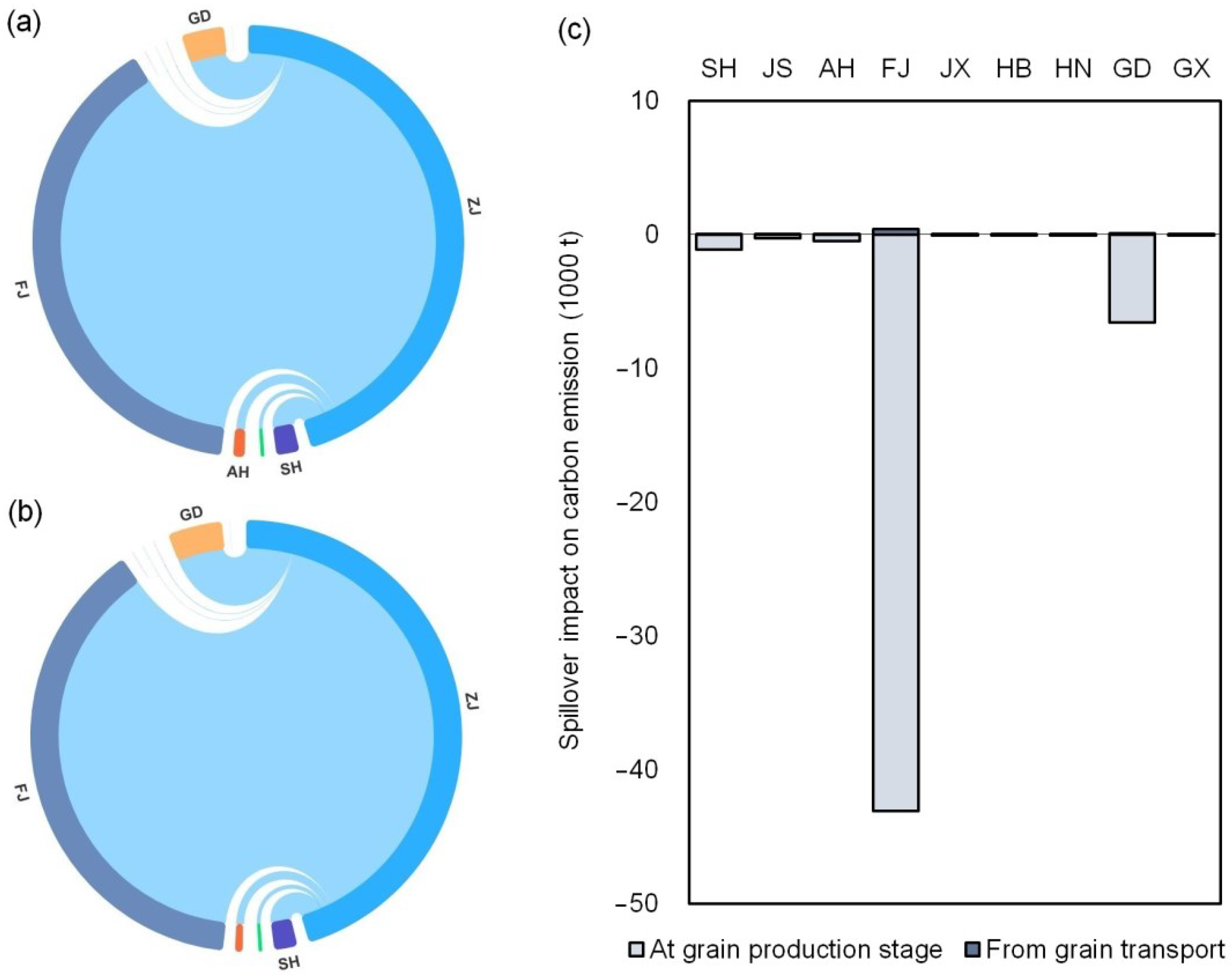
| Emission Source | Factor | Unit | References |
|---|---|---|---|
| Pesticide | 4.94 | t CO2e/t | [53] |
| Fertilizer | 0.86 | t CO2e/t | [53] |
| Electricity applied in irrigation | 0.19 | t CO2e/hm2 | Average CO2 factors of China’s regional power grids in 2011 and 2012, published by China Climate Change Information Network; Greenhouse gas reporting: Conversion factors 2018, published by UK government; China Development and Reform Commission; Summary of cost and income of agricultural products in China in 2018 |
| Plastic film | 3.15 | t CO2e/t | Greenhouse gas reporting: Conversion factors 2018, published by UK government |
| Agricultural machinery | 0.06 | t CO2e/kW | IPCC, 2006; Greenhouse gas reporting: Conversion factors 2018, published by UK government |
| Transport Mode | Carbon Emission Conversion Factor (kgCO2e/ton-km) |
|---|---|
| Road | 0.11364 |
| Railway | 0.02601 |
| Waterway | 0.01315 |
| Products | Grain Consumption Coefficient (kg/kg) | Data Sources |
|---|---|---|
| Livestock and poultry meat | 2.29 | [44,54] |
| Milk and milk products | 0.39 | [55] |
| Eggs | 1.70 | [44,55] |
| Aquatic products | 1.02 | [55] |
| Impact on Grain Production (1000 t) | Impact on Carbon Emissions (1000 t) | ||
|---|---|---|---|
| Local Impact | Spillover Impact | Total Impact | |
| 1870 | 261 | −668 | −407 |
Disclaimer/Publisher’s Note: The statements, opinions and data contained in all publications are solely those of the individual author(s) and contributor(s) and not of MDPI and/or the editor(s). MDPI and/or the editor(s) disclaim responsibility for any injury to people or property resulting from any ideas, methods, instructions or products referred to in the content. |
© 2024 by the authors. Licensee MDPI, Basel, Switzerland. This article is an open access article distributed under the terms and conditions of the Creative Commons Attribution (CC BY) license (https://creativecommons.org/licenses/by/4.0/).
Share and Cite
Tang, L.; Shen, G.; Cheng, M.; Zuo, C.; Li, F.; Liu, H.; Wu, S. Spillover Impacts of the Utilization of Winter Fallow Fields on Grain Production and Carbon Emissions. Land 2024, 13, 1300. https://doi.org/10.3390/land13081300
Tang L, Shen G, Cheng M, Zuo C, Li F, Liu H, Wu S. Spillover Impacts of the Utilization of Winter Fallow Fields on Grain Production and Carbon Emissions. Land. 2024; 13(8):1300. https://doi.org/10.3390/land13081300
Chicago/Turabian StyleTang, Lanping, Ge Shen, Min Cheng, Chengchao Zuo, Feiyang Li, Hang Liu, and Shaohua Wu. 2024. "Spillover Impacts of the Utilization of Winter Fallow Fields on Grain Production and Carbon Emissions" Land 13, no. 8: 1300. https://doi.org/10.3390/land13081300
APA StyleTang, L., Shen, G., Cheng, M., Zuo, C., Li, F., Liu, H., & Wu, S. (2024). Spillover Impacts of the Utilization of Winter Fallow Fields on Grain Production and Carbon Emissions. Land, 13(8), 1300. https://doi.org/10.3390/land13081300






